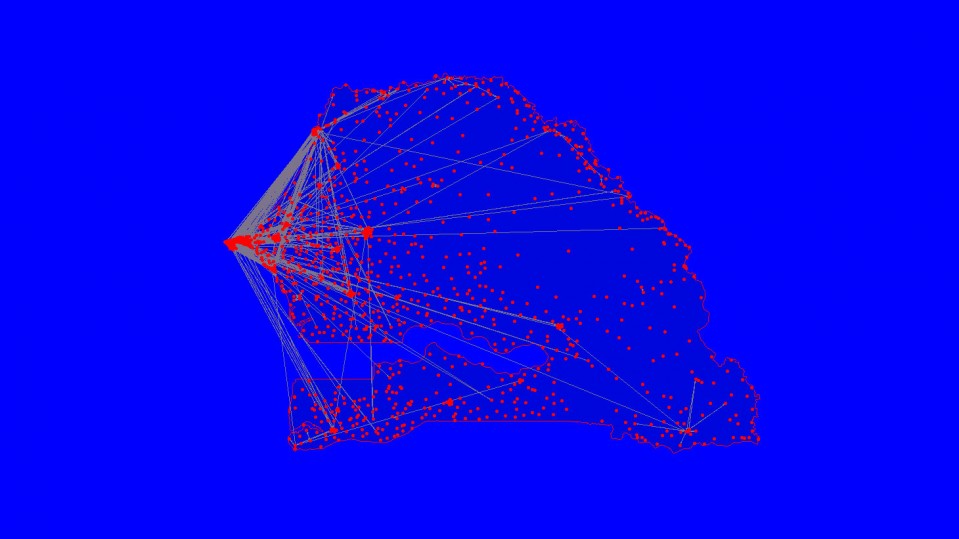

Smart Cities
How much electricity does a country use? Just ask cell-phone users.
Mobile-phone data looks set to change the way infrastructure is planned in the developing world.

Socioeconomic data is generally expensive and difficult to gather. The most important data generally comes from censuses and reveals the size of the population, its geographical distribution, its age and gender structure, and a host of other details.
But a census requires significant, costly planning, carefully analysis, and a relatively stable society. That makes such studies hard to do in the developing world, where countries are often by afflicted by poverty, war, disease, and famine.
So economists, sociologists, and policy experts would dearly love a cheaper and faster way to gather data. And in recent years, just such a method has emerged thanks to mobile phones.
Mobile phones have spread widely in the developing world, more quickly than other services such as electrification. In Senegal, for example, only 24% of households are electrified, and yet 75% have mobile phones, with people presumably charging them from car engines, from neighbors, or wherever they can.
Mobile-phone data is a veritable treasure trove of detail about society and the human condition. Researchers have used it to better understand mobility patterns, to study human reproductive strategies, and to measure literacy levels. And economists have used it to map wealth in developing countries.
That raises the possibility that mobile-phone data could supplement and in some cases replace census results. But just how much more useful can this data be?
Today, we get a partial answer thanks to the work of Hadrien Salat and colleagues at the Future Cities Laboratory in Singapore. These guys have analyzed mobile-phone data from Senegal and say it has the potential to help infrastructure planning for the entire country.
It can also be used to estimate factors such as electricity usage even when it includes just a fraction of total inhabitants. “Our aim is to use the resulting data to reduce the logistic costs of gathering information for infrastructure planning in developing countries,” they say.
The team’s method was straightforward. They started with population data from the last census in Senegal, dating from 2013. This measured the population density in the country’s 552 communes, or administrative divisions.
They also gathered anonymized mobile-phone data for the entire country, including the number of calls and texts, the phone masts they called from and to, the call length. and so on.
The team also gathered data on electricity consumption, an important measure for infrastructure planning. This data is harder to get. Salat and co estimated it using satellite images of the country at night and by measuring the amount of light produced in each commune.
The key question they then ask is how these data sets are correlated with each other. “We combine various data sets from Senegal to evaluate mobile phone data’s potential to replace insufficient census data for infrastructure planning,” they say.
The results offer some interesting surprises. For example, they find that mobile-phone activity is not strongly correlated with the population density found in the census. However, mobile-phone activity is strongly correlated with electricity consumption. Indeed, it is a significantly better indicator than population density.
At first sight that is something of a puzzle. But Salat and co explain the result by suggesting that electricity consumption is the result of a range of interlinked activities that are better correlated with mobile-phone usage than with the density of people alone.
The team also go on to show how they can process the mobile-phone data to give a better estimate of population density and electricity consumption, even when the data covers as little as a third of population.
That’s interesting work with significant potential. As a proof-of-principle demonstration, it shows how mobile-phone data is an important proxy for electricity consumption in the developing world. It’s not hard to imagine how planners might exploit that kind of insight.
And it is straightforward to update the data on a regular basis at relatively low cost. That’s in stark contrast to census data, which is hugely expensive to gather and is updated relatively rarely.
Of course, the approach is not perfect. One problem is understanding the market share of the mobile-phone provider and how it varies from one region to the next. That would give the results greater accuracy.
Nevertheless, results so far suggest that mobile-phone data has the potential to dramatically change the way government agencies, planners, and economists measure and think about economies and infrastructure planning. This data could provide an important contribution toward reducing poverty and increasing entrepreneurship in these places.
Ref: arxiv.org/abs/1907.04812 : Mobile Phone Data’s Potential For Informing Infrastructure Planning In Developing Countries